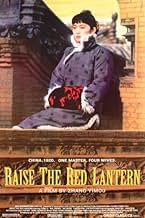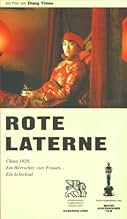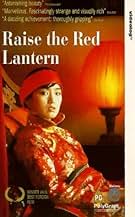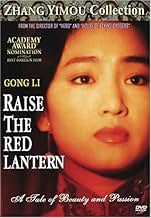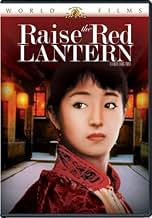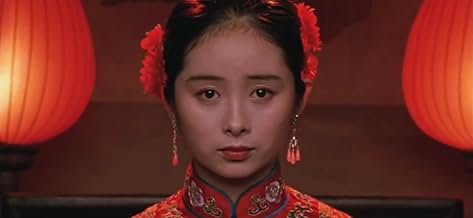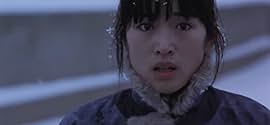NOTE IMDb
8,1/10
37 k
MA NOTE
Une jeune femme devient la quatrième épouse d'un riche seigneur et doit apprendre à vivre avec les règles strictes et les tensions du foyer.Une jeune femme devient la quatrième épouse d'un riche seigneur et doit apprendre à vivre avec les règles strictes et les tensions du foyer.Une jeune femme devient la quatrième épouse d'un riche seigneur et doit apprendre à vivre avec les règles strictes et les tensions du foyer.
- Réalisation
- Scénario
- Casting principal
- Nommé pour 1 Oscar
- 23 victoires et 15 nominations au total
Zengyin Cao
- Old Servant
- (as Zhengyin Cao)
Zhigang Cui
- Dr. Gao
- (as Zhihgang Cui)
Espérance Pham Thai Lan
- Kids - Concubines
- (non crédité)
Avis à la une
I can certainly understand why this film is so critically acclaimed. Raise The Red Lantern is one of the only Chinese movies I've seen, but I'll definitely admit that it's unusual to see a film this stylistically masterful come out of Hollywood (although it can happen -- The Thin Red Line, for example). A lot of what makes this film work is Zhang Yimou's outstanding directorial style; his use of color against bleak background is especially effective. It's his hypnotic visuals that keep you interested throughout the slow progression of the story. And the amazing acting by most of the performers doesn't hurt, either; everything feels completely real.
I think of this as one of those movies that you aren't supposed to enjoy; it shocks you, and leaves you just as disturbed as, considering the subject matter, you should be. The miserable story of Yan'er, the servant girl, is especially painful to watch, and the same goes for the unfolding of the last few scenes. But I think the fact that I was so unsettled by this movie probably just goes to show how well it gets its points across. And along with the remarkable acting and directing, that's definitely something to be respected.
I think of this as one of those movies that you aren't supposed to enjoy; it shocks you, and leaves you just as disturbed as, considering the subject matter, you should be. The miserable story of Yan'er, the servant girl, is especially painful to watch, and the same goes for the unfolding of the last few scenes. But I think the fact that I was so unsettled by this movie probably just goes to show how well it gets its points across. And along with the remarkable acting and directing, that's definitely something to be respected.
Every frame of this film explodes with excellent acting, cinematography, music and art direction. I never thought I would see something so beautiful in a foreign film since Ingmar Bergman's work. This is by no means, an art film this is a human film, while holding an ethnic background these people portrayed in the film are all of us and is probably what we would call a fable on the cruelty of humanity. I'am disgusted to discover this film isn't on video or DVD in america. It seems as if its popularity has run thin since the 90's but this is a masterpiece people!
I had a good day, so I selected this film. I have several films that I reserve for good days because I know they will reward. Its a sort of celebration that will send me into rich dreams, annotating my life.
This has two known qualities that you, dear reader, can expect without knowing anything about the film itself.
First, you will know that this is a woman directed by someone deeply in love with her. This doesn't always produce great films, but when the director is inherently cinematic, it often evokes something deep in the viewer. There is nothing in the world like looking on the face the person you are centered on. A million subtle decisions are made in each scene, summing to an effect that cannot be missed. If this had poor narrative qualities (and some of their films did) it would still have this quality of seeing into a soulmate deeply enough to be able to animate the skin.
Its quite interesting when you consider the woman. If you see her outside of film, or in films made by ordinary eyes, she is quite ordinary. She has an atypical Chinese body: busty and widehipped. She is poised but doesn't have the neck or cheekboned face of other Asian women. Only under this man's eye is she a goddess. You can see this in the very first shot.
The second thing you can count on is the architectural anchoring of the thing. This man knows how to use space. He uses it in the cinematic narrative, for example, if you replay the shots where the house of death is shown, and then the last encounter with it... And if you understand why the decisions about handling distance and surfaces were made they way they were, you will have entered a zone where from now on you will not be able to reason without reasoning with place.
But there are other handlings of space: As with some of his other films, the building is a character. Its the noir narrator who sets the rules often arbitrary under which all characters are bound to operate, and which drives the narrative. Its a particularly western notion, this, and has gotten our hero in trouble, even banned. This part is following Welles and Kubrick.
But he goes further than either of them with this notion that the light both has agency of its own (it selects which of the four wives gets a foot massage and sex) and is a part of the fabric of the buildings. The redness changes the spaces it occupies, bringing intrigue with the sex, desire for several things. Its quite layered, what is going on. These lanterns are the real master; in fact the person who inhabits the master's body is hardly even there. We never see his face.
Because of the extensive use of hard planes and selfish light, there aren't many fabric effects here, as we'll see elsewhere.
I am tempted to designate this as one of my two allowed "must see before you die" films of 1991. But I'm in too good a mood to make such a serious decision.
Ted's Evaluation -- 3 of 3: Worth watching.
This has two known qualities that you, dear reader, can expect without knowing anything about the film itself.
First, you will know that this is a woman directed by someone deeply in love with her. This doesn't always produce great films, but when the director is inherently cinematic, it often evokes something deep in the viewer. There is nothing in the world like looking on the face the person you are centered on. A million subtle decisions are made in each scene, summing to an effect that cannot be missed. If this had poor narrative qualities (and some of their films did) it would still have this quality of seeing into a soulmate deeply enough to be able to animate the skin.
Its quite interesting when you consider the woman. If you see her outside of film, or in films made by ordinary eyes, she is quite ordinary. She has an atypical Chinese body: busty and widehipped. She is poised but doesn't have the neck or cheekboned face of other Asian women. Only under this man's eye is she a goddess. You can see this in the very first shot.
The second thing you can count on is the architectural anchoring of the thing. This man knows how to use space. He uses it in the cinematic narrative, for example, if you replay the shots where the house of death is shown, and then the last encounter with it... And if you understand why the decisions about handling distance and surfaces were made they way they were, you will have entered a zone where from now on you will not be able to reason without reasoning with place.
But there are other handlings of space: As with some of his other films, the building is a character. Its the noir narrator who sets the rules often arbitrary under which all characters are bound to operate, and which drives the narrative. Its a particularly western notion, this, and has gotten our hero in trouble, even banned. This part is following Welles and Kubrick.
But he goes further than either of them with this notion that the light both has agency of its own (it selects which of the four wives gets a foot massage and sex) and is a part of the fabric of the buildings. The redness changes the spaces it occupies, bringing intrigue with the sex, desire for several things. Its quite layered, what is going on. These lanterns are the real master; in fact the person who inhabits the master's body is hardly even there. We never see his face.
Because of the extensive use of hard planes and selfish light, there aren't many fabric effects here, as we'll see elsewhere.
I am tempted to designate this as one of my two allowed "must see before you die" films of 1991. But I'm in too good a mood to make such a serious decision.
Ted's Evaluation -- 3 of 3: Worth watching.
This movie has it all, betrayal, conflict and tragedy. I have to say that I couldn't live without it, effectively anyway. The political criticisms tear at the spine of the film and the beauty of it in such an intimate setting is outstanding. The use of such a rich, three dimensional setting defies what we have been taught by the mainstream as being beautiful and sets a standard on a budget that I would love to be aware of, that all Hollywood movies should aspire to. It shows us that film, real film that is, does not need $100 million to look good, rather the combination of a haunting setting in the middle of vastness and the equally haunting beauty of it's star, Gong Li, but at it's heart the house itself resembles a claustrophobic pot, boiling over the surface.
This is in my opinion, Zhang Yimou's greatest film, it is a triumph in film form and narrative. The haunting sounds of flutes, a significant visual and audio element that has a mythical quality due to it's importance to Songlian and becomes an unattainable item of the gods when it is removed from existence when it is burned, becoming a tragic reminder on the attempts to vanquish the personalities of not only Songlian but all of the concubines. It's slow burning nature may repel the masses but anyone who can get a copy, do so without fail, you will never regret it. I cannot stress the importance of this film, we may see it as a study on the oppression of women in China, but this is universal, we westerners once did the same thing not too long ago.
For me the cinematography is what sells the film, it is the best I have ever seen and ever will. If there is ever a film to promote the use of the three strip technicolour process once again, this is it. Long after you have finished your post film analysis, the light from the red lanterns will still be searing in your eyes.
This is in my opinion, Zhang Yimou's greatest film, it is a triumph in film form and narrative. The haunting sounds of flutes, a significant visual and audio element that has a mythical quality due to it's importance to Songlian and becomes an unattainable item of the gods when it is removed from existence when it is burned, becoming a tragic reminder on the attempts to vanquish the personalities of not only Songlian but all of the concubines. It's slow burning nature may repel the masses but anyone who can get a copy, do so without fail, you will never regret it. I cannot stress the importance of this film, we may see it as a study on the oppression of women in China, but this is universal, we westerners once did the same thing not too long ago.
For me the cinematography is what sells the film, it is the best I have ever seen and ever will. If there is ever a film to promote the use of the three strip technicolour process once again, this is it. Long after you have finished your post film analysis, the light from the red lanterns will still be searing in your eyes.
10gbheron
"Raise the Red Lantern" is set at a Chinese baronial estate, the time, the 1920s. But, as the family-servant dynamics are placed on display, the viewer begins to feel it could be a thousand years earlier. The story is shown through the eyes of a young college-dropout played by Gong Li. Family misfortune has forced her into concubinage as the "fourth mistress" of the Chinese lord. A headstrong woman, her relationship with the lord's household, especially the other three mistresses, form the basis of the story. But it's telling is as important as the story itself. This is a beautiful, well-acted, well-directed movie. Slow-paced, it ingratiates itself with you, drawing you in deeper and deeper. I can't think of anything that warrants improvement. A masterpiece.
Le saviez-vous
- AnecdotesFilmed at the Qiao Family Compound near the city of Pingyao. The complex is now open for tours, however, nowhere is there any mention of the film.
- GaffesAround 01:18:59, there is a lot of smoke in front of the third wife. And there is almost no smoke in front of the second one.
- Citations
The Third Concubine: Good or bad, it's all playacting. If you act well, you can fool other people; if you do it badly, you can only fool yourself, and when you can't even fool yourself, you just can fool the ghosts.
Meilleurs choix
Connectez-vous pour évaluer et suivre la liste de favoris afin de recevoir des recommandations personnalisées
- How long is Raise the Red Lantern?Alimenté par Alexa
Détails
Box-office
- Montant brut aux États-Unis et au Canada
- 2 603 061 $US
- Week-end de sortie aux États-Unis et au Canada
- 22 554 $US
- 15 mars 1992
- Montant brut mondial
- 2 603 061 $US
- Durée
- 2h 5min(125 min)
- Couleur
- Rapport de forme
- 1.85 : 1
Contribuer à cette page
Suggérer une modification ou ajouter du contenu manquant


